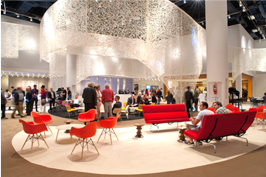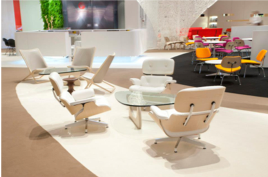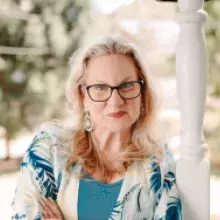Strategic events change behavior, support sales cycles and bring marketing messages to life. With a clear goal and firm understanding of the event’s desired outcome, a strategic vision is brought into focus. This vision is the foundation of the strategic plan, upon which layers of details are built, all of which come together to create an experience.
A true experience is achieved when attendees are enveloped in a multi-sensory engagement that reflects your strategic vision and goal. To do this effectively a professional spatial designer should be hired to make sure your vision is brought to life. If you’re unsure of where to find a spatial designer or what to expect from one when you do, you’re not alone. This powerful but somewhat unknown concept is slowly evolving from big budget installations to the mainstream.
Julian Lwin, Spatial Innovation & Experiential Design Director and founder of Lwindesign is the perfect person to explain the nuances of the field and why hiring an experiential design expert is something you may want to incorporate into your next program.
Julian is a soft-spoken, pensive man who prefers to observe before he speaks. But don’t mistake his silence for having nothing to say. Engage Julian in a conversation and you will find yourself being pulled towards his words and wanting to hear everything this genius is willing to share.
Here are the first of three excerpts from my conversation with Julian which I’m sharing with the hope that they will enlighten, inspire and bring a dash of flavor, texture, sound and color to your event design process.
What is a spatial innovation and experiential design director?
Julian Lwin: My role can be described as an omni-dimensional story teller. I take a client’s brand narrative and create an immersive “theatre-like" experience: designing the staging, lighting, sound, visual cues and custom designed decor. I orchestrate a journey that connects brand initiatives with an audience where for the performance the leading actors are cars, fashion collections, fragrances, data, technology or new product launches. My role as an experiential design director is similar to that of a theatre director - where every detail of a performance is stage-managed to evoke maximum empathy and meaningful enduring impact.
What is your background and how did you get started?
Julian Lwin: From an early age I had a keen interest in music, art and performance. I was fascinated by productions at the theatre and exhibitions in galleries. While studying English literature I was absorbed by the line, “All the world’s a stage” in William Shakespeare’s As You Like It (not specifically the seven stages of life the monologue refers to but with the crafting of lives within space). At that point I also began designing stage sets and loved how I could focus an audience’s attention on specific details by using lighting, props and backgrounds. Theatre design led me to recognize the similarities between presenting art in galleries and in designing sets for productions. In a gallery context the primary focus is to highlight the art work within a defined environment, here the gallery becomes a “backdrop” to present the art - not unlike a stage set.
I trained as an industrial designer in London at Central St. Martins School of Art and Design where I developed inter-disciplinary collaborations between fine art, graphics, ceramics, jewelry and fashion design students. This became the foundation for my journey to the “immersive” spatial and “experiential” design arena.
That sounds complicated, yet your designs are so natural.
Julian Lwin: For me, design not only solves problems with creative solutions and functionality but with beauty and personality. I find designing is a natural process as fluid as language.
The word ‘experiential’ is thrown about very casually in today’s language. What’s your definition of ‘experiential design’?
Julian Lwin: In a nutshell, ‘experiential’ design is when and where sensorial empathy is communicated at every user engagement point from the choice of construction materials and lighting to color psychology and the production of space. When a customer/consumer becomes truly immersed within the fabric (metaphorically) of an environment, the result is experiential - where tangible brand interaction and engagement take place.
Can you give me an example of something you designed, the idea behind it and what the onsite experience was?

 Julian Lwin: Working with Herman Miller for Art Basel Miami Beach was an amazing opportunity to create a unique “gallery” experience for an iconic American brand. The concept for this design was to showcase classic Eames furniture from the Herman Miller Collection designed in the 1950’s with newly updated contemporary colors, fabrics and materials. By overlaying the furniture on organically shaped flooring panels and nestled beneath an ethereal translucent canopy screen we drew attention to the vibrant new colors and textures of this fabulous collection. Visitors enjoyed being saturated by the fully immersive nature of the furniture experiencing a connection between the past and present - a truly visceral brand connection.
Julian Lwin: Working with Herman Miller for Art Basel Miami Beach was an amazing opportunity to create a unique “gallery” experience for an iconic American brand. The concept for this design was to showcase classic Eames furniture from the Herman Miller Collection designed in the 1950’s with newly updated contemporary colors, fabrics and materials. By overlaying the furniture on organically shaped flooring panels and nestled beneath an ethereal translucent canopy screen we drew attention to the vibrant new colors and textures of this fabulous collection. Visitors enjoyed being saturated by the fully immersive nature of the furniture experiencing a connection between the past and present - a truly visceral brand connection.
Julian has much more to share and he’s eager for you to learn more about how to bring a spatial innovation expert to your next program. See you back here in a month for more of our conversation!



 Julian Lwin: Working with Herman Miller for Art Basel Miami Beach was an amazing opportunity to create a unique “gallery” experience for an iconic American brand. The concept for this design was to showcase classic Eames furniture from the Herman Miller Collection designed in the 1950’s with newly updated contemporary colors, fabrics and materials. By overlaying the furniture on organically shaped flooring panels and nestled beneath an ethereal translucent canopy screen we drew attention to the vibrant new colors and textures of this fabulous collection. Visitors enjoyed being saturated by the fully immersive nature of the furniture experiencing a connection between the past and present - a truly visceral brand connection.
Julian Lwin: Working with Herman Miller for Art Basel Miami Beach was an amazing opportunity to create a unique “gallery” experience for an iconic American brand. The concept for this design was to showcase classic Eames furniture from the Herman Miller Collection designed in the 1950’s with newly updated contemporary colors, fabrics and materials. By overlaying the furniture on organically shaped flooring panels and nestled beneath an ethereal translucent canopy screen we drew attention to the vibrant new colors and textures of this fabulous collection. Visitors enjoyed being saturated by the fully immersive nature of the furniture experiencing a connection between the past and present - a truly visceral brand connection.